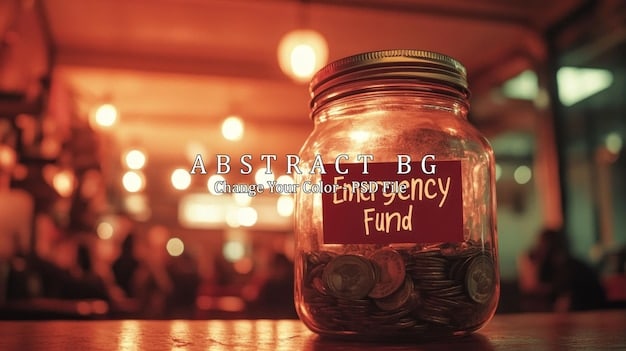Emergency Fund 2025: Calculate Your 6-Month Safety Net Now!

Is Your Emergency Fund Ready for 2025? Calculate Your 6-Month Safety Net Now: Preparing your emergency fund for 2025 involves assessing current expenses, setting a savings goal, and implementing strategies to achieve financial security for unexpected events, ensuring peace of mind and stability.
Are you prepared for the unexpected events that 2025 might bring? Having a solid emergency fund is crucial for financial security. Let’s explore how to ensure is your emergency fund ready for 2025? Calculate your 6-month safety net now!
Why You Need a 6-Month Emergency Fund
An emergency fund acts as a financial cushion during unexpected events like job loss, medical emergencies, or car repairs. Having a 6-month emergency fund can provide peace of mind and prevent you from going into debt.
The Importance of Financial Security
Financial security is about more than just having money. It’s about being able to handle life’s unexpected challenges without significant stress.
Avoiding Debt in Times of Crisis
Without an emergency fund, many people turn to credit cards or loans when faced with unexpected expenses. This can lead to high interest rates and long-term debt.
- Peace of mind during unexpected events
- Protection against debt accumulation
- Ability to handle job loss or medical emergencies
Investing in an emergency fund ensures you are prepared and can avoid high expenses when the unexpected arrives.

Assessing Your Current Financial Situation
Before calculating your 6-month safety net, it’s essential to understand your current financial situation. This involves evaluating your income, expenses, and existing savings.
Calculate Your Monthly Expenses
Start with tallying a list with all your monthly expenses. This includes rent/mortgage, utilities, groceries, transportation, healthcare, and other essential costs.
Determine Your Monthly Income
Add up all sources of income, including your salary, side hustles, and investments. This will provide a clear picture of the money coming in each month.
Understanding your monthly expenses and income is the foundation for calculating an accurate and sufficient emergency fund for your needs.
Calculating Your 6-Month Safety Net
Now that you have a clear understanding of your monthly expenses, you can calculate the amount you need to save for your 6-month emergency fund. This calculation will give you a specific savings goal to aim for.
Multiply Your Monthly Expenses by Six
To calculate your 6-month safety net, simply multiply your total monthly expenses by six. This will give you the total amount you need to cover six months of expenses.
Include Variable and Unexpected Costs
Keep in mind that your monthly expenses may vary. Be sure to include a buffer for unexpected costs, such as car repairs or medical bills.
By multiplying your expenses you get an accurate and reliable amount to consider when trying to create your emergency fund.

Strategies to Build Your Emergency Fund Quickly
Building an emergency fund can feel like a daunting task, but with the right strategies, you can reach your savings goal faster. Here are some tips to help you accelerate your progress.
Automate Your Savings
Set up automatic transfers from your checking account to your savings account each month. This ensures that you consistently save without having to think about it.
Reduce Non-Essential Expenses
Identify areas where you can cut back on spending. This could include dining out, entertainment, or subscriptions. Put the money you save towards your emergency fund.
- Cut back on non-essential expenses
- Set up automatic savings transfers
- Consider a side hustle for extra income
Consider your expenses and savings, and determine what actions and changes are needed in order to improve your finance for the coming year.
Where to Keep Your Emergency Fund
Where you keep your emergency fund is just as important as how much you save. You want to ensure that your money is safe, accessible, and earning some interest.
High-Yield Savings Accounts
These accounts offer higher interest rates than traditional savings accounts. They are a safe and liquid option for your emergency fund.
Money Market Accounts
Money market accounts are similar to savings accounts but may offer slightly higher interest rates. They also typically come with check-writing privileges.
Consider opening a high yield savings account for the most gains, and ensure your money is safe but also accessible.
Maintaining and Replenishing Your Emergency Fund
Once you’ve built your emergency fund, it’s important to maintain it and replenish it when necessary. Unexpected expenses will inevitably arise, so having a plan in place will help you stay prepared.
Regularly Review Your Expenses
Periodically review your monthly expenses to ensure that your emergency fund is still adequate. Adjust your savings goal if your expenses increase.
Replenish After Withdrawals
If you have to use your emergency fund, make it a priority to replenish it as soon as possible. Set up a plan to save a specific amount each month until you reach your goal.
Consistently reviewing your expenses and savings will help you ensure that your account is in order, and the correct amount is present.
| Key Point | Brief Description |
|---|---|
| 💰 Assess Expenses | Understand your monthly costs to set a savings target. |
| 🎯 Calculate 6-Month Goal | Multiply monthly expenses by six for your safety net amount. |
| 🚀 Automate Savings | Set up automatic transfers to build your fund faster. |
| 🏦 High-Yield Account | Keep your fund in a high-yield savings account for growth. |
FAQ
▼
The general recommendation is to have 3-6 months’ worth of living expenses saved to cover unexpected costs such as medical expenses, job loss, or car repairs.
▼
The ideal place is a high-yield savings account or money market account. You have easy access to the emergency funds here while also being able to gain some interest in the savings account.
▼
It’s a good idea to review your fund annually to ensure it still covers your expenses. Make adjustments based on any financial changes or any changes in the current economy.
▼
No, you should not use your emergency fund investments. Emergency funds should remain easily accessible and completely risk-free. Use other sources of income to invest.
▼
Begin even if you can only save a small amount, and automate the process to ensure consistency. Even saving small amounts on a frequent basis adds up over time.
Conclusion
By assessing your financial situation, calculating your 6-month safety net, and implementing effective savings strategies, you can ensure your emergency fund is ready for 2025 . Prioritizing your financial security will provide peace of mind and protect you from the unexpected challenges that may arise.





